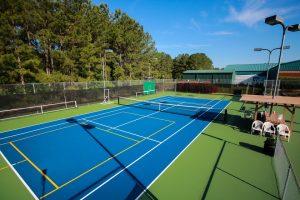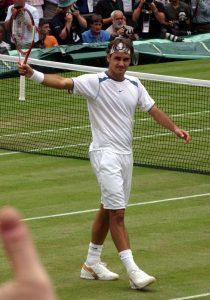We may earn money or products from the companies mentioned in this post.
Brief History of the Kick Serve in Tennis

The kick serve, also known as the topspin serve, has been a game-changer in the world of tennis This technique involves imparting heavy topspin on the ball, causing it to bounce high upon landing and making it difficult for opponents to return with precision The kick serve was first popularized by players like Arthur Ashe and Bjorn Borg in the 1970s, but its origins can be traced back even further
Importance of Having a Kick Serve in Your Arsenal

Having a kick serve in your arsenal can give you a significant advantage on the tennis court It allows you to control the pace and trajectory of your serves, keeping your opponents off balance and forcing them into defensive positions The kick serve is particularly effective against players who struggle with high-bouncing shots or have difficulty returning balls at shoulder height
Additionally, the kick serve can help you neutralize aggressive returners by taking away their ability to attack your serves effectively By consistently serving with spin and accuracy, you can force your opponents to hit defensive returns or make errors under pressure
Overview of the Post Content

In this post, we will delve deeper into how to execute a perfect kick serve We will provide step-by-step instructions on grip placement, body position, and swing technique We will also discuss common mistakes players make when attempting a kick serve and offer tips on how to overcome them
Furthermore, we will explore different variations of the kick serve such as the wide-kick serve and body-kick serve Understanding these variations will allow you to add an extra layer of unpredictability to your serves and keep your opponents guessing
Whether you’re a beginner looking to add a new weapon to your game or an advanced player seeking to refine your kick serve technique, this post will provide valuable insights and practical tips that can help you take your tennis game to the next level
Fundamentals of a Kick Serve

When it comes to serving in tennis, the kick serve is a powerful weapon that can give you an edge over your opponents This type of serve combines topspin and slice components to create a unique ball trajectory and bounce direction
Definition and characteristics of a kick serve
The kick serve is characterized by its ability to generate significant topspin and slice By brushing up on the back of the ball, players create topspin that causes the ball to dive downward quickly after crossing the net At the same time, a well-executed slice imparts sideways spin, making it difficult for opponents to return with accuracy
The combination of topspin and slice results in a high-bouncing ball that kicks up after landing on the opponent’s side of the court This unpredictable bounce can catch opponents off guard, forcing them into defensive positions or even causing them to mishit their return shots
Differences between flat, topspin, and kick serves
While all serves have their own unique characteristics, there are distinct differences between flat, topspin, and kick serves in terms of spin generation and court placement options
A flat serve is hit with minimal spin or none at all It tends to travel faster but has less margin for error when it comes to landing within the service box On the other hand, topspin serves involve brushing up on the back of the ball to create forward rotation This results in greater control over placement as well as increased net clearance
However, it is the kick serve that truly stands out due to its ability to generate both topspin and slice simultaneously This added spin not only allows players to clear obstacles such as nets or opponents closer to the net but also creates opportunities for strategic court placement
Advantages of using a kick serve
The kick serve offers several advantages that can greatly enhance your game on different court surfaces On clay courts, for example, the high-bouncing nature of the kick serve can cause opponents to struggle with their footwork, making it harder for them to return effectively
Furthermore, the versatility of the kick serve allows players to mix up their serving options during matches By varying the speed and spin of their serves, players can keep opponents guessing and prevent them from settling into a rhythm
In conclusion, mastering the fundamentals of a kick serve can give you an edge on the tennis court Its unique combination of topspin and slice creates a ball trajectory and bounce direction that can catch opponents off guard Whether you’re looking to control court placement or gain tactical advantages on different surfaces, incorporating the kick serve into your repertoire is a skill worth developing
Technique Breakdown: How to Execute a Kick Serve

Mastering the kick serve in tennis can give you a powerful weapon to disrupt your opponent’s rhythm and gain an advantage on the court To execute this technique effectively, it’s crucial to understand the proper grip that allows you to generate maximum spin The continental grip is ideal for a kick serve, as it enables you to utilize your wrist and forearm motion efficiently By holding the racket with the base knuckle of your index finger on bevel two, you can achieve optimal control and spin
1 Continental Grip Explanation
The continental grip involves placing your hand on the racket handle so that it runs diagonally across your palm from the bottom left corner to the top right corner This grip allows for versatility in shot selection, including powerful serves and effective volleys
2 Common Mistakes in Gripping the Racket
When gripping the racket for a kick serve, some players make common mistakes that hinder their performance One such mistake is gripping too tightly, which limits wrist flexibility and reduces spin potential Another error is holding the racket too low in the hand, resulting in less control and power during the swing It’s important to find a balance between firmness and freedom of movement when gripping the racket
The Correct Stance for Optimal Power and Balance

Your stance plays a crucial role in executing a powerful kick serve while maintaining balance throughout the shot Proper positioning relative to the baseline sets you up for success
1 Positioning Relative to the Baseline
To maximize power generation, align yourself slightly behind or on top of (closer to) the baseline when preparing for a kick serve This position gives you more room for upward swing motion and allows you to transfer energy from your lower body effectively
2 Foot Placement and Body Alignment
When setting up for a kick serve, place your lead foot (left foot for right-handed players) slightly ahead of the other foot, maintaining a shoulder-width stance This positioning helps generate power and enables efficient weight transfer during the serve Keep your knees slightly bent and your body aligned towards the target area
The Toss: Placing the Ball for Maximum Spin

The toss is a crucial element in executing an effective kick serve Proper placement of the ball can enhance spin potential and make it more challenging for your opponent to return
1 Toss Height Considerations
The ideal toss height for a kick serve is slightly higher than a flat or slice serve toss Aim to release the ball at a height that allows you to make solid contact around shoulder level or slightly above, giving you ample time to generate spin with your swing
2 Toss Location Relative to Your Body
Positioning the toss slightly in front of your body is key when executing a kick serve By tossing the ball in front of you, you create an optimal hitting zone where you can brush up on the backside of the ball, generating topspin and causing it to bounce higher upon landing
Tips, Drills, And Common Mistakes In Developing A Kick Serve

Mastering the kick serve can be a game-changer on the tennis court It adds variety to your game and keeps your opponents guessing To help you develop this powerful weapon, here are some practice tips to hone your technique:
1 Target practice on deuce or ad-court
When practicing your kick serve, it’s important to aim for specific targets on the court Start by focusing on one side of the court, either the deuce or ad-court, and consistently target that area with your serves This will help you improve your accuracy and build confidence in hitting your spots
2 Focus on specific aspects (toss, swing)
The kick serve requires proper coordination between the toss and swing Pay close attention to your toss placement and make sure it is consistent every time you serve Additionally, focus on developing a fluid swing motion that generates topspin to give your serve that signature kick
To further enhance consistency and effectiveness of your kick serve, incorporate these recommended drills into your training routine:
1 Progressive drills starting with half-swings
Start by practicing half-swing kick serves to get a feel for the technique without fully committing to a full swing motion Gradually increase the power and intensity as you become more comfortable with each repetition This drill helps develop muscle memory and control over ball spin
2 Coach or partner-based practice drills
Incorporate drills that involve a coach or training partner who can provide feedback and guidance during practice sessions Work together on specific aspects of the kick serve such as toss placement or racket drop, ensuring proper execution at each stage of the serve
While practicing, it’s important to be aware of common mistakes that may hinder your progress Here are two common mistakes to identify and fix:
1 Poor toss placement
A consistent and accurate toss is crucial for a successful kick serve Many players struggle with tossing the ball too far in front or too far behind them, resulting in inconsistent serves Focus on developing a smooth and controlled toss that allows you to make solid contact with the ball
2 Incorrect racket drop and follow-through
The racket drop is an essential part of generating topspin on your kick serve If your racket drop is too late or not executed properly, you won’t be able to achieve the desired spin on the ball Pay attention to your racket position during the swing motion and ensure a smooth follow-through to maximize the effectiveness of your serve
Lastly, mental preparation and match application are key factors in unleashing your kick serve during competitive play:
1 Strategic use of kick serve in matches
Understand when and how to strategically employ your kick serve during matches The kick serve can be a valuable weapon against opponents who struggle with high-bouncing balls or have difficulty returning wide serves Utilize this shot strategically to gain an advantage during crucial points
2 Adapting to opponents’ reactions
Pay attention to how your opponents react to your kick serve and make adjustments accordingly Observe their positioning, footwork, and returning patterns after they encounter your kick serves This information will help you adapt your game plan and exploit any weaknesses in their return game
In conclusion, developing a strong kick serve requires patience, practice, and attention to detail By following these tips, drills, and addressing common mistakes, you’ll be well on your way to mastering this valuable weapon in your tennis arsenal Keep pushing yourself and never stop striving for improvement!
Useful Links

How to Hit a Kick or Slice Serve in Tennis
Abandoning the kick serve? – Talk Tennis
The Key To Improving Your Top Spin Tennis Serve …
How to return a kick serve in tennis
Facts You Should Know About Slice and Kick Serves
5 Steps To A Successful Kick Serve
Kick Serve In Tennis | The Ultimate Guide
What Is A Kick Serve In Tennis
3 Types of Tennis Serves: Flat, Slice, and Kick Instruction
Tennis Kick Serve
(PDF) The kick serve in tennis
Learn kick serve instead of a normal serve? : r/10s
Building a Killer Kick Serve | New York Tennis Magazine
Kick serve. Meaning in tennis. Definition. Wiki. Terms
How to Hit a Tennis Kick Serve aka Topspin Serve
The Ultimate Topspin Tennis Serve Video Guide
Tennis skills: the slice first serve
How To Hit A Kick (Topspin) Serve






